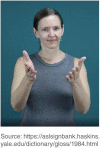A Usage-Based Proposal for Argument Structure of Directional Verbs in American Sign Language
- PMID: 35664145
- PMCID: PMC9157181
- DOI: 10.3389/fpsyg.2022.808493
A Usage-Based Proposal for Argument Structure of Directional Verbs in American Sign Language
Abstract
Verb agreement in signed languages has received substantial attention for a long time. Despite the numerous analyses about the linguistic status of verb agreement, there is little discussion about the argument structure associated with "directional verbs," also known as agreeing/agreement or indicating verbs. This paper proposes a usage-based approach for analyzing argument structure constructions of directional verbs in American Sign Language (ASL). The proposal offers low-level constructions for reported speech, non-dedicated passive and reflexive, and stance verb constructions, which capture the patterns, abstracted from recurring usage events, that are part of users' linguistic knowledge. The approach has potential to push the field of sign linguistics in new directions of understanding the interplay of language use and structure.
Keywords: American Sign Language; argument structure; construction grammar; usage-based linguistics; verb agreement.
Copyright © 2022 Hou.
Conflict of interest statement
The author declares that the research was conducted in the absence of any commercial or financial relationships that could be construed as a potential conflict of interest.
Figures







Similar articles
-
The development of complex verb constructions in British Sign Language.J Child Lang. 2002 Aug;29(3):655-75. doi: 10.1017/s0305000902005184. J Child Lang. 2002. PMID: 12109367
-
"It is important to consult" a linguist: Verb-Argument Constructions in ChatGPT and human experts' medical and financial advice.PLoS One. 2025 May 27;20(5):e0324611. doi: 10.1371/journal.pone.0324611. eCollection 2025. PLoS One. 2025. PMID: 40424337 Free PMC article.
-
Rules and construction effects in learning the argument structure of verbs.J Child Lang. 2003 Nov;30(4):797-821. doi: 10.1017/s0305000903005804. J Child Lang. 2003. PMID: 14686085
-
Looking at Viewpoint in ASL Through a Cognitive Linguistics Lens.Wiley Interdiscip Rev Cogn Sci. 2025 Mar-Apr;16(2):e70001. doi: 10.1002/wcs.70001. Wiley Interdiscip Rev Cogn Sci. 2025. PMID: 40107877 Free PMC article. Review.
-
Historical Linguistics of Sign Languages: Progress and Problems.Front Psychol. 2022 Mar 9;13:818753. doi: 10.3389/fpsyg.2022.818753. eCollection 2022. Front Psychol. 2022. PMID: 35356353 Free PMC article. Review.
References
-
- Barlow M. (1999). Agreement as a Discourse Phenomenon. Folia Linguist. 33 187–210. 10.1515/flin.1999.33.1-2.187 - DOI
-
- Barlow M., Kemmer S. (1994). “A schema-based approach to grammatical description,” in The reality of linguistic rules, eds Lima S. D., Corrigan R. L., Iverson G. K. (Amsterdam/Philadelphia: Benjamins; ), 19–42. 10.1075/slcs.26.05bar - DOI
-
- Börstell C., Jantunen T., Kimmelman V., de Lint V., Mesch J., Oomen M. (2019). Transitivity prominence within and across modalities. Open Linguist. 5 666–689. 10.1515/opli-2019-0037 - DOI

